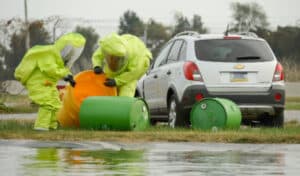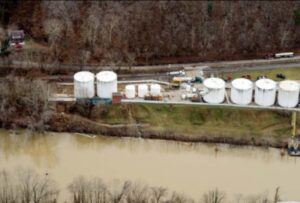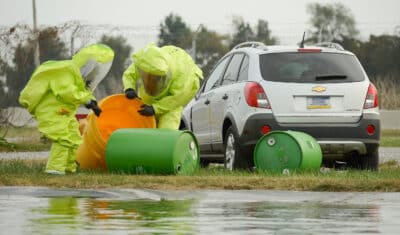How Chemical Storage Buildings Protect the Environment
When it comes to protecting the environment, discussions of the storage of hazardous chemical and other materials often centers on the negative effects that it can have on the safety of wildlife, water, and the earth. The demand for products and processes that are chemically intensive is not slowing down and continues to grow as they become an integral part of many industrial and daily uses. How can Chemical Storage buildings protect the environment?
An increase in chemicals used and hazardous waste created creates a larger responsibility to ensure everyone is maintaining current safety standards. This is where manufacturers of chemical and hazardous material storage buildings come in. Companies like U.S. Chemical Storage are committed to helping industries meet rigorous compliance standards to prevent environmental disasters. Learn more about our commitment to sustainability and safe environmental practices and the research that goes into maintaining this compliance.
The Role of the EPA in Environmental Compliance
The Environmental Protection Agency (EPA) “protects people and the environment from significant health risks, sponsors and conducts research, and develops and enforces environmental regulations” throughout the entire United States. The EPA is responsible for setting safety compliance guidelines for industries. The EPA regulates automobiles and pesticides, but there are also extensive requirements when it comes to the storage of chemicals, with more requirements being created every year.

These regulations are very important rules that are designed to protect you, your employees, and the nearby ecosystem. Even though the regulations will create more barriers when it comes to using and storing chemicals, it is vital to follow them for safety purposes, and that is where U.S. Chemical’s expertise comes into play. By talking with an experienced sales representative, you can save time, money, and avoid making any costly or dangerous errors.
Avoiding Environmental Disasters with Chemical Storage Buildings
You don’t often hear about chemical storage until it ends up in the news. A chemical or hazardous waste disaster might not seem like an imminent threat or, might happen so rarely that one might think, “it won’t ever happen to me.” However, when these disasters do make the news, they are often on a massive scale that leaves long-lasting, devastating effects on the community as well as long-term destruction of biodiversity if these chemicals end up leaching into the soil.
Chemical disasters can start in one of two ways, human error or natural disasters.
Human Error
Even though many recent events, such as the 2020 pandemic, have caused huge setbacks in the supply chain, industries are still determined to show growth year-over-year. Some experts point to this upward trend of quickly increasing production efficiency as an increased hazard for many who work in with and around these chemicals. Additionally, as more chemicals are stockpiled to prevent interruptions to future supply chain needs, larger capacity code-compliant storage solutions are also needed in case of a spill.
Demand for higher production often means utilizing automated technologies in place of humans, which decreases the number of people on-site who can monitor safety. This was contributing factor observed in Japan after a series of increasing chemical disasters at plants across the country, including Nippon Shokubai in Himeji, Hyogo Prefecture in 2013, and Mitsui Chemicals in Waki, Yamaguchi Prefecture in 2012.
Natural Causes
According to the Government Accountability Office, “nearly one-third of the hazardous chemical facilities in the United States are at risk from climate-driven floods, storms and wildfires.” Long-term implications of climate change notwithstanding, many facilities that manufacture chemicals or hazardous waste lie in a particularly vulnerable part of the United States susceptible to floods, especially from hurricanes.
Often, hurricanes knock out power or move debris inland through storm surges. To an unequipped facility, this renders protective measures useless, leading to leaks or explosions, like in Louisiana’s coastal zone where a chemical plant began leaking chlorine gas after the plant was damaged during Hurricane Laura in 2020.
Impacts on the Surrounding Ecosystem
How do these chemical facility disasters impact the surrounding environment? The effects of a chemical disaster long surpass the initial event. For example, in 2014 a Freedom Industries facility in West Virginia released crude MCHM, a chemical foam used to wash coal, into the Elk River. The immediate impact of the spill resulted in 300,000 area residents losing access to potable water.
 Without the proper containment, hazardous chemicals end up in the surrounding environment through run-off, groundwater contamination, and air pollution which can further infiltrate drinking water, food, and soil. Despite their necessity in daily products, many chemicals and hazardous materials have lasting effects on human health, including health abnormalities, cancer, genetic mutations, physiological malfunctions of organ failure and disease, physical deformations, and birth defects.
Without the proper containment, hazardous chemicals end up in the surrounding environment through run-off, groundwater contamination, and air pollution which can further infiltrate drinking water, food, and soil. Despite their necessity in daily products, many chemicals and hazardous materials have lasting effects on human health, including health abnormalities, cancer, genetic mutations, physiological malfunctions of organ failure and disease, physical deformations, and birth defects.
Protecting the Environment with Chemical Storage Buildings
There are steps you can take today to prevent a chemical disaster later. Investing in the proper chemical storage solution is not only an actionable step to preventing catastrophe, but it has operational benefits. These include increasing productivity through accessible chemical storage, well-lit storage rooms, loading ramps, gravity-fed pallet racks, and so much more. Chemical storage buildings offer customization options to create a solution uniquely designed for your company’s needs.
U.S. Chemical Storage offers EPA-compliant chemical storage buildings that feature secondary containment sumps designed as a protective measure to avoid leaching into the surrounding environment. The sump is sized depending on the code based on the volume of liquid being stored in the building.
Many chemical storage building applications dictate a 2-hour or 4-hour bi-directional fire rating—a need that is determined based on the Safety Data Sheet (SDS). This rating helps contain flammable materials in case of a fire for enough time for people to evacuate and for firefighters to arrive and contain the danger.
Getting Started with U.S. Chemical Storage
Working with chemicals and hazardous waste is a major responsibility, and that comes with adhering to strict regulations. Chemical storage buildings will protect the environment. Bring your operations up to compliance with the help of U.S. Chemical Storage. Our team of chemical storage engineers are always happy to take on new projects and help you design the optimal solution for your industry. Request a free quote for a chemical storage building or contact us to get in touch with one of our experts.
Interested in more resources on the EPA and hazardous waste? Check out these:

 These regulations are very important rules that are designed to protect you, your employees, and the nearby ecosystem. Even though the regulations will create more barriers when it comes to using and storing chemicals, it is vital to follow them for safety purposes, and that is where U.S. Chemical’s expertise comes into play. By talking with an experienced sales representative, you can save time, money, and avoid making any costly or dangerous errors.
These regulations are very important rules that are designed to protect you, your employees, and the nearby ecosystem. Even though the regulations will create more barriers when it comes to using and storing chemicals, it is vital to follow them for safety purposes, and that is where U.S. Chemical’s expertise comes into play. By talking with an experienced sales representative, you can save time, money, and avoid making any costly or dangerous errors.
 Without the proper containment, hazardous chemicals end up in the surrounding environment through run-off, groundwater contamination, and air pollution which can further infiltrate drinking water, food, and soil. Despite their necessity in daily products, many chemicals and hazardous materials have lasting effects on human health, including health abnormalities, cancer, genetic mutations, physiological malfunctions of organ failure and disease, physical deformations, and birth defects.
Without the proper containment, hazardous chemicals end up in the surrounding environment through run-off, groundwater contamination, and air pollution which can further infiltrate drinking water, food, and soil. Despite their necessity in daily products, many chemicals and hazardous materials have lasting effects on human health, including health abnormalities, cancer, genetic mutations, physiological malfunctions of organ failure and disease, physical deformations, and birth defects.
